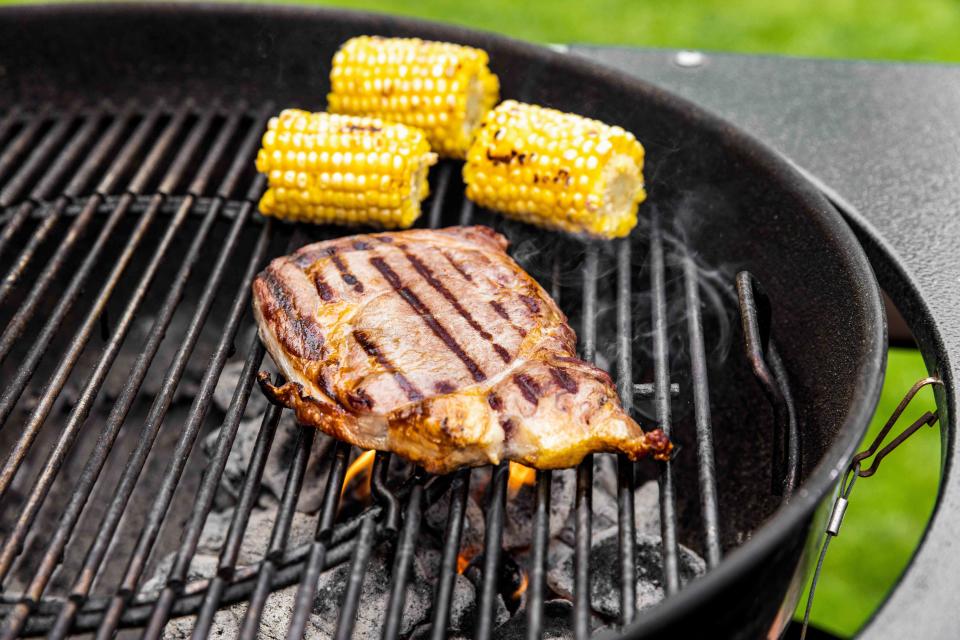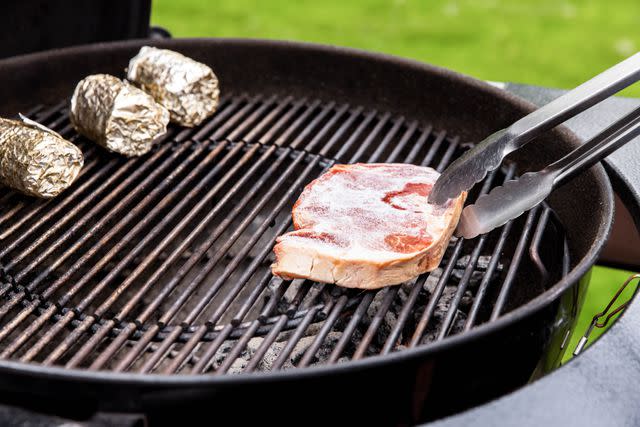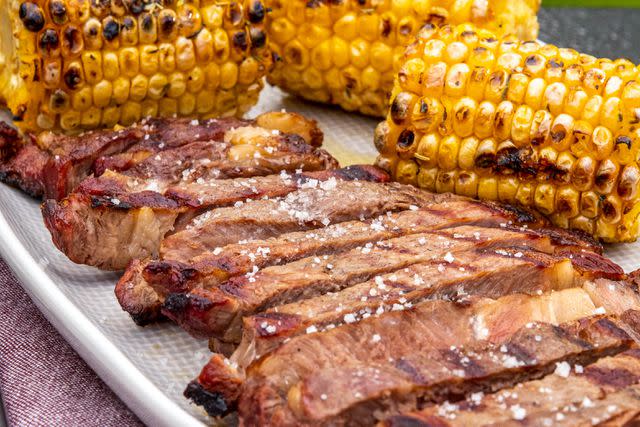The 9 Foods You Can Grill From Frozen, According to a Grilling Expert
How easy would weeknight dinners be if you didn't have to remember to thaw the food before grilling?

Simply Recipes / Mike Lang
The freezer is my friend when it comes to last-minute weeknight dinners. I'm a huge fan of frozen vegetables, I keep my freezer stocked with individual portions of frozen cooked grains, and I frequently bake frozen fish without defrosting it first—yes, you can do that! Imagine how easy weeknight dinners on the grill would be if you didn't have to remember to defrost whatever you want to eat.
For an expert take on grilling frozen foods, I spoke to Dan Zuccarello, Executive Food Editor for cookbooks at America’s Test Kitchen. Zuccarello oversaw their brand-new book The Outdoor Cook. In other words, he knows a thing or two about grilling. Read on for the nine foods you can throw straight from the freezer onto the grill, and his tips for grilling from frozen.

Simply Recipes / Mike Lang
9 Foods You Can Grill From Frozen
1. Steaks
Believe it or not, a steak cooked from frozen can be even juicier and tastier than when it’s thawed first. America's Test Kitchen recommends starting the frozen steaks over a hot fire to develop a nicely browned crust on both sides, then moving them over to the cooler side until cooked to your desired internal temperature.
2. Beef Burgers and Other Meat Burgers
Since they're thin and cook quickly, burgers are great candidates for grilling from frozen. "I would just cook burger patties over a hot grill because by the time you get a nice sear on the outside, the inside of the burger is going to be properly cooked," says Zuccarello.
3. Veggie Burgers
Most store-bought veggie burgers are designed to be cooked from frozen, and the same treatment works for homemade veggie burgers. Putting the burgers on the grill while frozen reduces the chance of them falling apart, plus it gets nice browning on the outside without drying out the inside.
4. Pizza
Like with store-bought veggie burgers, most frozen pizzas are meant to be cooked from frozen—some brands even provide grill instructions. Be sure the crust is pre-cooked, as raw frozen dough is likely to stick to the grill. If the pizza doesn't have grill instructions, mimic the oven instructions by grilling at the same temperature with the lid down.
Read More: Quit Baking Frozen Pizza—Here’s a Better Way To Cook It
5. Salmon and Other Fish Filets
Fish is a little trickier to cook from frozen than a burger or a steak because it sticks so easily. Zuccarello suggests starting it over low heat with the lid down to create an oven-like effect, then moving it to the hot side for a quick sear before serving.
6. Thin Chicken Cutlets
Choosing thin, flat cutlets is your best bet for grilling chicken from frozen. You can throw them on the hot grill and sear on both sides—by the time you have nice grill marks on the outside, the inside should be perfectly cooked. Use your meat thermometer to be sure! You’re looking for 165°F measured at the thickest part of the cutlet.
7. Pork Chops
As long as the frozen pork chops are flat and relatively uniform in thickness, they're great for grilling. For thicker chops, Zuccarello recommends starting them in the hot zone and then transferring them to the cool side, or vice versa—the order is not important as long as they get time in both zones. Thinner chops can be cooked over high heat the whole time. Check that the chops reach 145 ºF at the thickest part.
8. Corn on the Cob
Frozen corn on the cob is excellent for grilling, especially when fresh local corn isn't in season. Zuccarello suggests wrapping it in foil and steaming it on the cool side of the grill, then finishing it off on the hot side. Serve it with a compound butter or make elote with crema, mayo, herbs, and cotija.
9. Vegetables
Zuccarello recommends grilling vegetables from frozen to allow them to char without drying out on the inside. Choose larger vegetables or vegetable pieces, oiling them well, and using a grill basket to keep them from falling through the grates, like frozen green beans, artichokes, asparagus, and mushrooms.

Simply Recipes / Mike Lang
7 Tips for Grilling From Frozen
1. Choose flat foods
It's a good idea to choose flat foods with a uniform thickness so that they touch the surface of the grill evenly, Zuccarello says. That way you don't end up with charred spots and raw spots. Steaks and burgers are two great examples.
2. Use a well-seasoned grill
A well-seasoned grill helps keep food from sticking—it’s particularly important when you're starting from frozen since it will take longer for the food to form the crust that helps it release from the grill.
Oil the grill well before putting the food on, says Zuccarello. He recommends dipping a wad of paper towels in oil and then using tongs to hold the paper towels to rub the grates.
3. Preheat the grill
Be sure to preheat the grill. Zuccarello recommends at least 15 minutes for gas and 5 minutes for charcoal.
4. Set up a two-zone grill
Whether you are cooking with a charcoal or gas grill, you'll likely need different heat zones so you can start the food on a higher heat and move it to a lower heat or vice versa. This will allow the food to defrost, so you don't end up with food that's black on the outside and icy on the inside.
5. Plan on extra grilling time
When starting from frozen, estimate that you'll need at least 50% longer for whatever you're cooking.
6. Use a thermometer
The best way to tell if your food is done is to use an instant-read thermometer—that's always true but especially when you're cooking from frozen since you are probably not going to be using a recipe that was written for frozen food.
7. Consider a sauce or glaze
Since you can't marinate food that's frozen, Zuccarello suggests making a simple sauce or glaze to brush on afterwards. He usually grabs whatever herbs he has in the fridge, minces them, and combines them with an acidic ingredient, like vinegar or lemon juice, and some oil, plus salt and pepper. For extra flavor, cut up the herbs on the same cutting board as the cooked meat to create a "board sauce."

